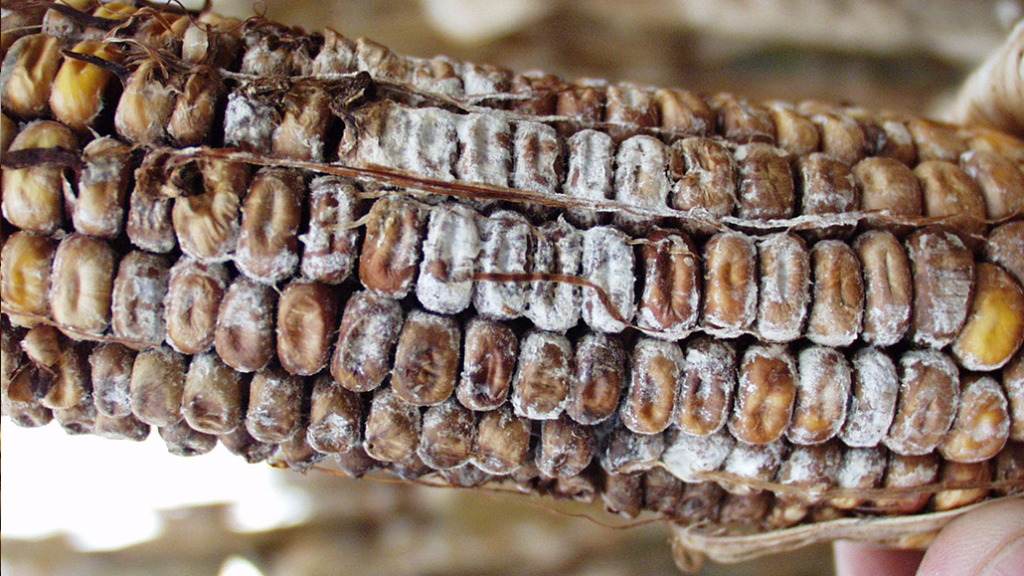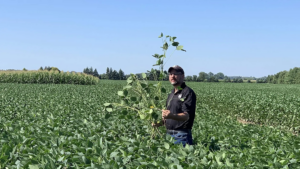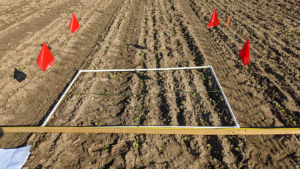Taking the fight to Fusarium
ONGOING RESEARCH TO MITIGATE ITS IMPACT

UNIVERSITY OF GUELPH researchers are finding and validating new chemical and biological weapons in the battle against Fusarium, a fungal disease that has devastating effects on wheat and corn crops.
CHEMICALS
“Adepidyn is a relatively new chemical that could be useful to suppress or reduce Fusarium head blight (FHB) in wheat and Fusarium graminearum in corn and the toxins in both crops,” says Dr. Dave Hooker, associate professor in the university’s Department of Plant Agriculture. “We wanted to compare it to existing tools to evaluate its effectiveness.”
While Adepidyn — the active ingredient in Miravis Ace, a Syngenta product — has been on the market for a couple of years, previously, there were only a handful of fungicides available that all belonged to one class of chemistry called triazoles. The new product belongs to a different class of chemistry that behaves differently on the plants.
“We know that with any chemical product we apply, nature will find a path of resistance,” Hooker says, adding that, while right now, the incidence of Fusarium resistance is low, researchers didn’t want it to get out of control.
It is a big problem. The cost of FHB is high — an estimated $2 billion in losses in the U.S. between 1993 and 2001 and losses of $520 million in Canada in the 1990s. After the devastating fall of 2018, when high levels of DON mycotoxin infected corn fields throughout southwestern Ontario, Grain Farmers of Ontario estimated losses of $200 million to farmer-members due to discounted and rejected loads.
Hooker and now-retired Dr. Art Schaafsma oversaw the project, forming the basis of Katiani Eli’s successfully defended Ph.D. thesis. Ruoxi Xia was also on the team and obtained her master’s degree in wheat. Both have published papers in the World Mycotoxin Journal.
“In corn, the results were similar to the results with the triazoles,” Hooker says. “On the wheat side, the results were as good, if not better than the triazoles.”
In fact, there was a bump in the wheat yield, and the crop stayed green longer through protection against premature senescence with the Miravis Ace than with the more traditional products.
Studies began in Ridgetown in 2017 when the grain was inoculated with Fusarium, and favourable conditions for the fungus were maintained. During field scale trials, the incidence of Fusarium was much lower, but the same results were found.
Hooker says that the ideal time for spraying the new fungicide on wheat is during full flowering when at least 50 per cent of the anthers on the heads are exposed. In corn, it is when the silks have fully emerged, right before they turn brown.
“The window of application for both should be within about a week,” he says. While the maximum efficacy for suppression during the research was 80 per cent, Hooker says that the average would be about 50 per cent.
“That’s using the best technology for spraying — if there is poor coverage, for example, the per cent of suppression goes down,” he says, adding that ground application is best because aerial spraying tends not to be as consistent with coverage.
With Ontario’s shortage of ground applicators, Hooker says using aerial sprayers is better than not spraying at all.
“Deciding on spray times is important — getting it wrong could result in substantial losses,” he says, advising that it’s best to spray fungicide as close as possible to the time the crops need it, depending on the weather, geography, and other factors.
Hooker recommends using Miravis Ace in rotation with a triazole product because all are equally effective, and using both kinds of products is healthier in terms of combatting resistance in Fusarium.
BIOLOGICALS
While plant breeding and new fungicides have reduced the Fusarium threat to a certain extent, Dr. Manish Raizada thinks microbes would be a good addition to the arsenal. Raizada is a professor in the University of Guelph’s Department of Plant Agriculture.
“Our target is that our microbes will allow farmers to reduce their fungicide rates by 50 per cent and that those savings would pay for the microbes, so there’s no added cost,” he says
Raizada says that there have been many efforts all around the world to control Fusarium with microbes but very little to show for it.
“Our hypothesis was that there might be microbes along that silk channel that suppress Fusarium,” he says, adding that he and others in the past have been looking at the seeds, at the soil and a number of different places, but not in corn silks.
In 2020, his team examined the silk microbiome and reported that there are hundreds of species of bacteria in corn silk.
When they challenged the silk with Fusarium, there were about 12 to 17 microbes that went up in numbers.
“That was a real aha moment — they were the ones we wanted to focus on,” he says.
In parallel, they cultured out bacteria from corn, selected the ones that were increasing in numbers with exposure to Fusarium and started testing.
Beginning with Petri dishes, the team moved to greenhouse trials, measuring yield and mycotoxins, and finally, they went to field trials.
“We isolated 1,300 bacteria from Canadian corn and another 300 from wild corn — some of which had been around for thousands of years — from across the Americas,” he says. He adds that they only used the safest bacteria from a human health perspective.
Using the same methods, they approached the problem in wheat. There, the Fusarium spreads through the central grain stem of the wheat head — or the rachis.
Currently, the testing for both crops is at different stages of completion. The wide-ranging project was started in 2017 and comprises a large team, including collaborators Dr. Victor Limay Rios of the Ridgetown campus and Dr. Lana Reid from Agriculture and Agri-Food Canada. Other researchers included post-doctoral fellow Dr. Eman Khalaf, Ph.D. student Michelle Thompson, MSc student Jake Gregory, Ph.D. student Anuja Shrestha, and MSc student Jade Muileboom.
“Overall, we can say that the best microbes are reducing DON mycotoxin by 90 per cent,” Raizada says, pointing out that the tests were carried out under severe Fusarium pressure — like in the fall of 2018. Some of the microbes were attacking other mycotoxins, as well.
Many of the microbes tested are reducing DON mycotoxin by at least 50 per cent.
“Where possible, we used microbes that form spores because they can be delivered to farmers in a powder form,” he says. They also used microbes that don’t form spores and have to be refrigerated.
In addition to the microbes in silks, Raizada’s team found that there are microbes in the pollen that fertilizes the corn plant.
“The microbes are coming from both silk and pollen,” he says, noting that the process of fertilization is what brings Fusarium into the plant in the first place.
At the time of writing, the team was awaiting mycotoxin data from the 2022 crop.
“What we’ve found over the years, there’s a certain amount of inconsistency in microbes, so that’s why, with further funding, we may be able to breed the microbes with the plants to improve field-level stability,” he says.
The team is also testing to ensure that fungicides do not adversely affect the bacterial microbes so they can be sprayed together in an integrated pest management program.
“Right now, our goal is that reduction in fungicide use, which we think is reachable,” he says.
The projects were funded by Grain Farmers of Ontario, the Natural Sciences and Engineering Research Council of Canada, Agriculture and Agri-Food Canada (AgricScience Clusters Program through the Organic Science Cluster), Ontario Ministry of Agriculture, Food and Rural Affairs, Ontario Trillium Scholarship, Ontario Genomics SPARK, and Syngenta. •










